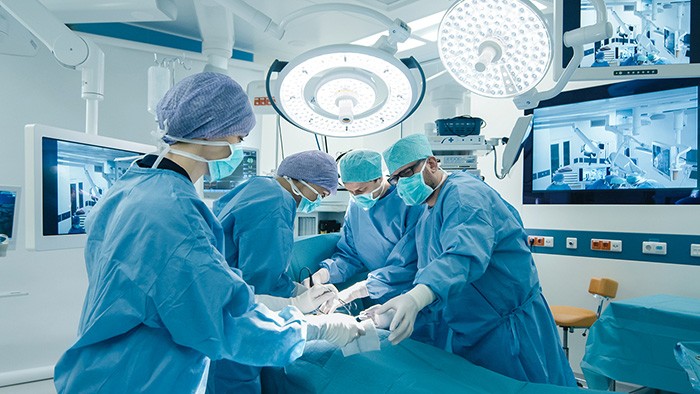Why hospitals need audio-visual integration
07 January 2019
Both operating rooms and interventional labs can benefit from integrating their audio, video and image sources. Audio-visual integration opens the way for many possibilities, such as in terms of how and when healthcare professionals can view images. With modern solutions for image management, the recording of medical procedures is becoming the new standard. As interventional labs and ORs get connected within the hospital and beyond, sharing medical images and procedures is easier and more cost-effective than ever before – rapidly increasing the potential for medical training.
Bringing unexpected benefits
What challenges does audio-visual integration address? Some challenges may already be known, such as the need to control monitors in the interventional lab so that they show relevant information in the right place, for a better overview of the patient and the image information. Or finding images faster by consolidating several PACS archives.
But what if the surgeon could watch previously recorded surgeries before or during the current surgery, for example? What if medical students or colleagues could be in a conference room, but still see and hear what’s going on in the OR and interventional lab? These are some of the benefits that audio-visual integration can bring to hospitals.
The rationale for recording medical procedures
Another feature of audio-visual integration is recording difficult interventional procedures or surgeries. Setting up automatic recording for predefined events, such as the crash alarm being triggered, is not a thing of the future – it is already possible.
The reason for recording may be to create educational material or simply for self-review and improvement. In fact, improving the quality of care and preventing medical errors are major reasons for recording today. Healthcare professionals naturally want to answer questions such as "Did I make the right decision?", "What did I learn?" and "How do I make sure this does not happen again?"
Promoting medical training
Medical training is a critical component in developing the quality of care. Audio-visual integration enhances medical training through the sharing of high-quality bi-directional audio, video and images from the OR and interventional lab to a conference room or congress, where students can follow surgical procedures live, and even ask questions, without being physically present in the room.
When audio-visual sources are fully integrated, medical professionals will not have to rely on the availability of a satellite team to broadcast medical procedures – it can be done with the push of a button and without the room being overcrowded.
Gaining access to remote expertise
Facing the challenge of adopting and learning to use advanced surgical procedures, techniques, surgical robots or state-of-the-art medical equipment may be dauting, but will get easier in the future with audio-visual integration. If experts (also known as proctors) can control cameras and select image sources remotely, they can provide the operator or surgeon with remote guidance.
Diagnosing patients based on diagnostic images and deciding the best course of action can sometimes be quite hard and require an expert opinion or a multi-disciplinary team (MDT) meeting. Audio-visual integration supports this process by enabling virtual MDT meetings with synchronized sharing and viewing of DICOM material.
Undoubtedly, audio-visual integration can and will contribute to the continuous improvement of healthcare standards around the world.
Meet Medical Imaging Technologies at Arab Health 2019
With audio-visual solutions from Medical Imaging Technologies, you can view, record, share and store audio, video and image sources – connecting the interventional lab and operating room, both within the hospital and beyond.
We invite you to meet us at Arab Health in hall 4, booth F70, on 28-31 January 2019 at Dubai World Trade Center. We look forward to seeing you there to discuss how you too can record and share medical procedures and the benefits this can bring, for both healthcare professionals and patients.
About Medical Imaging Technologies
Founded in 2009 and proudly headquartered in Lund, Sweden, Medical Imaging Technologies provides complete audiovisual integration for hospitals.
Our image management technology enables medical professionals to record, share and save video, audio and image sources.
We also provide the solutions required for medical professionals to access remote training and expertise, control monitors, record medical procedures, share DICOM-material and distribute live audiovisual information to conference rooms or congresses. We do this by connecting interventional labs and operating rooms within the hospital and beyond. Our products are used in medical disciplines such as interventional cardiology, surgery, and speech-language pathology. With more than 100 installations at 40 hospitals across 12 countries, we are an international group of companies operating in India, the Nordics, United Arab Emirates and United Kingdom.
Medicinsk Bildteknik AB, a fully owned sister company, develop and manufacture our products. Medicinsk Bildteknik AB has obtained ISO-13485 certification on its quality management system, which confirms its ability to provide medical devices and related services that consistently meet customer and applicable regulatory requirements.
Contact details
Sameh Ali, Regional Manager – MENAT
+971 (0)56 158 68 00
[email protected]
Medical Imaging Technologies
PB 121444, SAIF Zone, Sharjah, United Arab Emirates
Anna Wanland, marketing manager
+46 (0)46 540 09 70
[email protected]
Medical Imaging Technologies
Porfyrvägen 5, 224 78 Lund, Sweden
www.medicalimagingtechnologies.com



